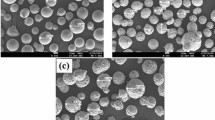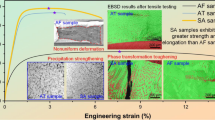Abstract
The friction stir process has been used for the first time to fabricate copper–diamond composite. The initial diamond particles were fragmented and embedded into Cu alloy due to the pressures applied during the friction stir process. A drastic refinement of the diamond particles was observed due to attrition during processing. Chromium (Cr) particles in the base Cu alloy have also been refined during friction stir process which appears to further promote grain refinement in Cu. The Cu–diamond interface appears to have good adhesion, except at chipped corners of some particles. The Cr particles decorate the Cu–diamond interface indicating a strong affinity of Cr to the diamond surface. Also, the adhesion of Cr particles is better on the surface of smaller fragmented diamond particles. The thermal conductivity of the composite is lower than friction stir-processed copper and as-received copper alloy due to significant grain refinement and the presence of Cu–diamond interfaces. However, the fabricated composite may find potential uses in commercial applications due to the unique combination of increased hardness and high thermal conductivity.













Similar content being viewed by others
References
Zhang Y, Li J, Zhao L, Wang X (2015) Optimisation of high thermal conductivity Al/diamond composites produced by gas pressure infiltration by controlling infiltration temperature and pressure. J Mater Sci 50:688–696
Tan Z, Li Z, Fan G, Kai X, Ji G, Zhang L et al (2013) Diamond/aluminum composites processed by vacuum hot pressing: microstructure characteristics and thermal properties. Diam Relat Mater 31:1–5
Monje I, Louis E, Molina J (2013) Optimizing thermal conductivity in gas-pressure infiltrated aluminum/diamond composites by precise processing control. Compos A Appl Sci Manuf 48:9–14
Ruch P, Beffort O, Kleiner S, Weber L, Uggowitzer PJ (2006) Selective interfacial bonding in Al (Si)–diamond composites and its effect on thermal conductivity. Compos Sci Technol 66:2677–2685
Abyzov AM, Kruszewski MJ, Ciupiński Ł, Mazurkiewicz M, Michalski A, Kurzydłowski KJ (2015) Diamond–tungsten based coating–copper composites with high thermal conductivity produced by pulse plasma sintering. Mater Des 76:97–109
Raza K, Khalid FA (2014) Optimization of sintering parameters for diamond–copper composites in conventional sintering and their thermal conductivity. J Alloy Compd 615:111–118
Sinha V, Gengler JJ, Muratore C, Spowart JE (2015) Effects of disorder state and interfacial layer on thermal transport in copper/diamond system. J Appl Phys 117:074305
Kang Q, He X, Ren S, Zhang L, Wu M, Liu T et al (2013) Preparation of high thermal conductivity copper–diamond composites using molybdenum carbide-coated diamond particles. J Mater Sci 48:6133–6140
Fan Y-M, Guo H, Xu J, Chu K, Zhu X-X, Jia C-C (2011) Effects of boron on the microstructure and thermal properties of Cu/diamond composites prepared by pressure infiltration. Int J Min Metall Mater 18:472–478
Zhang Y, Zhang H, Wu J, Wang X (2011) Enhanced thermal conductivity in copper matrix composites reinforced with titanium-coated diamond particles. Scripta Mater 65:1097–1100
Yoshida K, Morigami H (2004) Thermal properties of diamond/copper composite material. Microelectron Reliab 44:303–308
Moore AL, Shi L (2014) Emerging challenges and materials for thermal management of electronics. Mater Today 17:163–174
Kidalov SV, Shakhov FM (2009) Thermal conductivity of diamond composites. Materials 2:2467–2495
Bai G, Li N, Wang X, Wang J, Kim MJ, Zhang H (2018) High thermal conductivity of Cu-B/diamond composites prepared by gas pressure infiltration. J Alloy Compd 735:1648–1653
Chen H, Jia C-C, Li S-J, Jia X, Yang X (2012) Selective interfacial bonding and thermal conductivity of diamond/Cu-alloy composites prepared by HPHT technique. Int J Min Metall Mater 19:364–371
Rosinski M, Ciupinski L, Grzonka J, Michalski A, Kurzydlowski K (2012) Synthesis and characterization of the diamond/copper composites produced by the pulse plasma sintering (PPS) method. Diam Relat Mater 27:29–35
Zhang H, Liu Y, Zhang F, Zhang D, Zhu H, Fan T (2018) Hot deformation behavior and processing maps of diamond/Cu composites. Metall Mater Trans A 49:2202–2212
Zhang H, Qi Y, Li J, Wang J, Wang X (2018) Effect of Zr content on mechanical properties of diamond/Cu-Zr composites produced by gas pressure infiltration. J Mater Eng Perform 27:714–720
Arai S, Ueda M (2019) Fabrication of high thermal conductivity Cu/diamond composites at ambient temperature and pressure. AIP Adv 9:085309
Tian Y, Li Q, Wang Z-D, Wang G-D (2015) Effects of ultra fast cooling on microstructure and mechanical properties of pipeline steels. J Mater Eng Perform 24:3307–3314
Abyzov AM, Kidalov SV, Shakhov FM (2011) High thermal conductivity composites consisting of diamond filler with tungsten coating and copper (silver) matrix. J Mater Sci 46:1424–1438
Abyzov AM, Shakhov FM, Averkin AI, Nikolaev VI (2015) Mechanical properties of a diamond–copper composite with high thermal conductivity. Mater Des 87:527–539
Rape A, Liu X, Kulkarni A, Singh J (2013) Alloy development for highly conductive thermal management materials using copper-diamond composites fabricated by field assisted sintering technology. J Mater Sci 48:1262–1267
Jia S, Yang F (2021) High thermal conductive copper/diamond composites: state of the art. J Mater Sci 56:2241–2274
Zhang C, Wang R, Cai Z, Peng C, Feng Y, Zhang L (2015) Effects of dual-layer coatings on microstructure and thermal conductivity of diamond/Cu composites prepared by vacuum hot pressing. Surf Coat Technol 277:299–307
Mizuuchi K, Inoue K, Agari Y, Tanaka M, Takeuchi T, Tani J-I et al (2016) Effect of boron addition on the thermal properties of diamond-particle-dispersed Cu-matrix composites fabricated by SPS. J Mater Sci Chem Eng 4:1
Li J, Wang X, Qiao Y, Zhang Y, He Z, Zhang H (2015) High thermal conductivity through interfacial layer optimization in diamond particles dispersed Zr-alloyed Cu matrix composites. Scripta Mater 109:72–75
Ekimov E, Suetin N, Popovich A, Ralchenko V (2008) Thermal conductivity of diamond composites sintered under high pressures. Diam Relat Mater 17:838–843
Sahraeinejad S, Izadi H, Haghshenas M, Gerlich A (2015) Fabrication of metal matrix composites by friction stir processing with different particles and processing parameters. Mater Sci Eng A 626:505–513
Hou W, Shen Z, Huda N, Oheil M, Shen Y, Jahed H et al (2021) Enhancing metallurgical and mechanical properties of friction stir butt welded joints of Al–Cu via cold sprayed Ni interlayer. Mater Sci Eng, A 809:140992
Hou W, Ding Y, Huang G, Huda N, Shah LHA, Piao Z et al (2022) The role of pin eccentricity in friction stir welding of Al-Mg-Si alloy sheets: Microstructural evolution and mechanical properties. Int J Adv Manuf Technol 121:7661–7675
Shah L, Huda N, Esmaeili S, Walbridge S, Gerlich A (2020) Structural morphology of Al-Mg-Si alloy friction stir welds through tool eccentricity. Mater Lett 275:128098
Surekha K, Els-Botes A (2011) Development of high strength, high conductivity copper by friction stir processing. Mater Des 32:911–916
Khodaverdizadeh H, Mahmoudi A, Heidarzadeh A, Nazari E (2012) Effect of friction stir welding (FSW) parameters on strain hardening behavior of pure copper joints. Mater Des 35:330–334
Moghaddam MS, Parvizi R, Haddad-Sabzevar M, Davoodi A (2011) Microstructural and mechanical properties of friction stir welded Cu–30Zn brass alloy at various feed speeds: influence of stir bands. Mater Des 32:2749–2755
Izadi H, Nolting A, Munro C, Bishop D, Plucknett K, Gerlich A (2013) Friction stir processing of Al/SiC composites fabricated by powder metallurgy. J Mater Process Technol 213:1900–1907
Rabkin E, Gutman I, Kazakevich M, Buchman E, Gorni D (2005) Correlation between the nanomechanical properties and microstructure of ultrafine-grained copper produced by equal channel angular pressing. Mater Sci Eng, A 396:11–21
Dobatkin S, Gubicza J, Shangina D, Bochvar N, Tabachkova N (2015) High strength and good electrical conductivity in Cu–Cr alloys processed by severe plastic deformation. Mater Lett 153:5–9
Bachmaier A, Rathmayr GB, Bartosik M, Apel D, Zhang Z, Pippan R (2014) New insights on the formation of supersaturated solid solutions in the Cu–Cr system deformed by high-pressure torsion. Acta Mater 69:301–313
Islamgaliev R, Nesterov K, Bourgon J, Champion Y, Valiev R (2014) Nanostructured Cu-Cr alloy with high strength and electrical conductivity. J Appl Phys 115:194301
Moelle C, Werner M, SzuÈcs F, Wittorf D, Sellschopp M, Von Borany J et al (1998) Specific heat of single-, poly-and nanocrystalline diamond. Diam Relat Mater 7:499–503
Banerjee B (2005) An evaluation of plastic flow stress models for the simulation of high-temperature and high-strain-rate deformation of metals. ar**v preprint cond-mat/0512466
Monachon C, Weber L, Dames C (2016) Thermal boundary conductance: A materials science perspective. Ann Rev Mater Res 46:433
Brown R (1981) The effect of dislocations on thermal conductivity. J Phys Colloq 42:C6-271-C6-3
Kotchetkov D, Zou J, Balandin A, Florescu D, Pollak FH (2001) Effect of dislocations on thermal conductivity of GaN layers. Appl Phys Lett 79:4316–4318
Hasselman D, Johnson LF (1987) Effective thermal conductivity of composites with interfacial thermal barrier resistance. J Compos Mater 21:508–515
Chu K, Jia C, Guo H, Li W (2013) On the thermal conductivity of Cu–Zr/diamond composites. Mater Des 45:36–42
Bai G, Wang L, Zhang Y, Wang X, Wang J, Kim MJ et al (2019) Tailoring interface structure and enhancing thermal conductivity of Cu/diamond composites by alloying boron to the Cu matrix. Mater Charact 152:265–275
Burger N, Laachachi A, Ferriol M, Lutz M, Toniazzo V, Ruch D (2016) Review of thermal conductivity in composites: mechanisms, parameters and theory. Prog Polym Sci 61:1–28
Chen H, Jia C, Li S (2012) Interfacial characterization and thermal conductivity of diamond/Cu composites prepared by two HPHT techniques. J Mater Sci 47:3367–3375
Cho HJ, Yan D, Tam J, Erb U (2019) Effects of diamond particle size on the formation of copper matrix and the thermal transport properties in electrodeposited copper-diamond composite materials. J Alloy Compd 791:1128–1137
Hagio T, Park J-H, Naruse Y, Goto Y, Kamimoto Y, Ichino R et al (2020) Electrodeposition of nano-diamond/copper composite platings: improved interfacial adhesion between diamond and copper via formation of silicon carbide on diamond surface. Surf Coat Technol 403:126322
Arai S, Ueda M (2020) Fabrication of high thermal conductivity copper/diamond composites by electrodeposition under potentiostatic conditions. J Appl Electrochem 50:631–638
He X, Zhang Z, Liu P, Zhu P, Guan H, Nan J et al (2022) Research on maximizing the diamond content of diamond/SiC composite. J Eur Ceram Soc 42:3127–3134
Гopдeeв C, Кopчaгинa C, Зaпeвaлoв B, Пapшин B, Cepoв E (2021) Aлмaзoкapбидкpeмниeвый кoмпoзит в кaчecтвe эффeктивнoгo пoглoтитeля микpoвoлн. Элeктpoникa и микpoэлeктpoникa CBЧ 1:30–34 (In russian)
EduPack G (2021) Granta design: Cambridge. UK
Beygelzimer Y, Kulagin R, Fratzl P, Estrin Y (2021) The earth’s lithosphere inspires materials design. Adv Mater 33:2005473
Qi Y, Kosinova A, Kilmametov AR, Straumal BB, Rabkin E (2018) Plastic flow and microstructural instabilities during high-pressure torsion of Cu/ZnO composites. Mater Charact 145:389–401
Acknowledgement
This work was supported by the Gerald Schwartz and Heather Reisman Foundation through a research grant promoting collaboration between the University of Waterloo and the Technion.
Author information
Authors and Affiliations
Corresponding author
Additional information
Handling Editor: Megumi Kawasaki.
Publisher's Note
Springer Nature remains neutral with regard to jurisdictional claims in published maps and institutional affiliations.
Supplementary Information
Below is the link to the electronic supplementary material.
Rights and permissions
Springer Nature or its licensor (e.g. a society or other partner) holds exclusive rights to this article under a publishing agreement with the author(s) or other rightsholder(s); author self-archiving of the accepted manuscript version of this article is solely governed by the terms of such publishing agreement and applicable law.
About this article
Cite this article
Huda, N., Bisht, A., Moreau, E. et al. Fabrication of copper–diamond composite by friction stir processing. J Mater Sci 58, 4184–4198 (2023). https://doi.org/10.1007/s10853-023-08279-9
Received:
Accepted:
Published:
Issue Date:
DOI: https://doi.org/10.1007/s10853-023-08279-9




